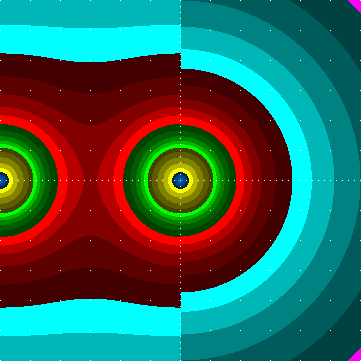



|

|

|
| In left plots, specific illuminances by a continuous row of luminaires spaced 5 and 6 heights are shown in their left halves (right half concerns a single luminaire). | The right plot is for a single luminaire, unrotated. | |

Values below the scale are illuminance / 1 lx. This is for (unrealistic) “unit” case that luminaires would have lamps producing 1 klm only, would be point-like and just 1 m over the terrain.
# IESNA: LM-63-1995
# [TEST] 763053
# [DATE] 2/10/84
# [MANUFAC] COOPER LIGHTING
# [LUMCAT] EGL91SXX44
# [LUMINAIRE] 1000W HPS 4H X 4V FLOOD
# [LAMP] 1000W HPS CL E-25
# [_REFLECTOR] SPUN ALUMINUM
# [_REFRACTOR] CLEAR FLAT GLASS
# [_SOCKET POSITION] AXIAL
# [_LAMP LUMENS] 140000
# TILT=NONE
# Bulbs: 1, 140000 lm each
# Number of measured angles: 46 vertical, 1 horizontal ones
# Photometric type: 1, Units type: 1
# Luminous opening diameter (and height?): 1.830 ( 1.750 )
# Ballast factor: 1, Input power: 1000 W
# Source file: egl91s44.ies
# Luminaire flux = 91755 lm,
# 65.5 % of the bulb flux
# between 75 and 90: 3.6 % of the luminaire flux
# - this part causes just GLARE in case of road lighting and similar purposes
# 80deg and above: max 18.0 cd / 1000 lm , 2.1 % of the luminaire flux
# 90deg and above: max 0.0 cd / 1000 lm , 0.0 % of the luminaire flux
# CutOff Type: Full_CutOff
# 62.5 deg to <67.5 deg: max 27 cd / 1000 lm,
# 67.5 deg to < 76 deg: max 21 cd / 1000 lm,
# maximum spec. lum. intensity 1874 cd / 1000 lm
# The following table gives luminous intensities which would be produced
# using a hypothetic bulb giving a luminous flux of 1000 lm (i.e., cd/klm):
0.0 1874
2.0 1851
4.0 1576
6.0 1274
8.0 1049
10.0 934
12.0 714
14.0 402
16.0 354
18.0 316
20.0 284
22.0 260
24.0 240
26.0 223
28.0 208
30.0 193
32.0 181
34.0 173
36.0 166
38.0 160
40.0 153
42.0 143
44.0 132
46.0 119
48.0 101
50.0 81.4
52.0 63.6
54.0 51.5
56.0 44.3
58.0 38.5
60.0 33.9
62.0 29.4
64.0 27.5
66.0 24.2
68.0 20.9
70.0 19.0
72.0 18.6
74.0 18.4
76.0 18.3
78.0 18.1
80.0 18.0
82.0 17.9
84.0 17.9
86.0 17.7
88.0 17.8
90.0 0.0